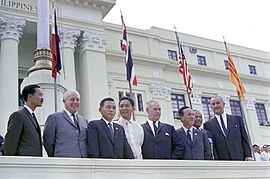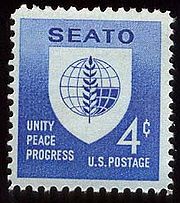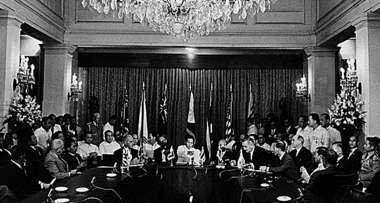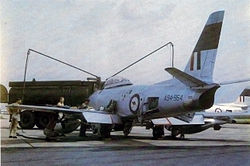- Southeast Asia Treaty Organization
-
Southeast Asia Treaty Organization 
SEATO's flag.Abbreviation SEATO Formation 8 September 1954 Extinction 30 June 1977 Type intergovernmental military alliance Headquarters Bangkok, Thailand Region served Southeast Asia Membership 8 states Australia
Australia France
France New Zealand
New Zealand Pakistan (including East Pakistan, now Bangladesh)
Pakistan (including East Pakistan, now Bangladesh) Philippines
Philippines Thailand
Thailand United Kingdom
United Kingdom United States
United States
 The leaders of some of the SEATO nations in front of the Congress Building in Manila, hosted by Philippine President Ferdinand Marcos on 24 October 1966.
The leaders of some of the SEATO nations in front of the Congress Building in Manila, hosted by Philippine President Ferdinand Marcos on 24 October 1966.
The Southeast Asia Treaty Organization (SEATO) was an international organization for collective defense in Southeast Asia created by the Southeast Asia Collective Defense Treaty, or Manila Pact, signed in September 1954 in Manila, Philippines. The formal institution of SEATO was established on 19 February 1955 at a meeting of treaty partners in Bangkok, Thailand.[1] The organization's headquarters were also located in Bangkok.
Primarily created to block further communist gains in Southeast Asia, SEATO is generally considered a failure because internal conflict and dispute hindered general use of the SEATO military; however, SEATO-funded cultural and educational programs left long-standing effects in Southeast Asia. SEATO was dissolved on 30 June 1977 after multiple members lost interest and withdrew.
Contents
Origins and structure
SEATO was created by the Southeast Asia Collective Defense Treaty, or Manila Pact, signed on 8 September 1954 in Manila,[2] as part of the American Truman Doctrine of creating anti-communist bilateral and collective defense treaties.[3] These treaties and agreements were intended to create alliances that would contain communist powers (Communist China, in SEATO's case).[4] This policy was considered to have been largely developed by American diplomat and Soviet expert George F. Kennan. President Dwight D. Eisenhower's Secretary of State John Foster Dulles (1953–1959) was the primary force behind the creation of SEATO, which expanded the concept of anti-communist collective defense to Southeast Asia.[2]
SEATO was planned to be a Southeast Asian version of the North Atlantic Treaty Organization (NATO),[5] in which the military forces of each member would be coordinated to provide for the collective defense of the members' country. Organizationally, SEATO was headed by the Secretary General, whose office was created in 1957 at a meeting in Canberra,[6][7] with a council of representatives from member nations and an international staff. Also present were committees for economics, security, and information.[7] SEATO's first Secretary General was Pote Sarasin, a Thai diplomat and politician who had served as Thailand's ambassador to the U.S. between 1952 and 1957,[8][9] and as Prime Minister of Thailand from September 1957 to 1 January 1958.[10]
Unlike the NATO alliance, SEATO had no joint commands with standing forces.[11] In addition, SEATO's response protocol in the event of communism presenting a "common danger" to the member nations was vague and ineffective, though membership in the SEATO alliance did provide a rationale for a large-scale U.S. military intervention in the region during the Vietnam War (1955–1975).[12]
Membership
SEATO's members included Australia, France, New Zealand, Pakistan (including East Pakistan, now Bangladesh), the Philippines, Thailand, the United Kingdom, and the United States.[11] The membership reflected a mid-1950s combination of anti-communist Western nations and such nations in Southeast Asia. The United Kingdom, Australia and the United States, the latter of which joined after the U.S. Senate ratified the treaty by a 82–1 vote,[13] represented the strongest Western powers.[14]
Because of the 1954 Geneva Conference settling the First Indochina War (1946–1954), South Vietnam, Cambodia, and Laos were not SEATO members.[11] They were, however, granted military protection,[11] though Cambodia rejected the protection in 1956.[15] Canada considered joining, but decided against it in order to concentrate on its NATO responsibilities.[16]
Military aspects
After its creation, SEATO quickly became insignificant militarily, as most of its member nations contributed very little to the alliance.[16] While SEATO military forces held joint military training, they were never employed because of internal disagreements. SEATO was unable to intervene in conflicts in Laos because France and Britain rejected use of military action.[15] As a result, the U.S. provided unilateral support for Laos after 1962.[15] Though sought by the U.S., involvement of SEATO in the Vietnam War was denied because of lack of British and French cooperation.[13][15]
Both the United States and Australia cited the alliance as justification for involvement in Vietnam.[16] American membership in SEATO provided the United States with a rationale for a large-scale U.S. military intervention in Southeast Asia.[12] Other countries, such as Great Britain and key nations in Asia, accepted the rationale.[12] In 1962, as part of its commitment to SEATO, the Royal Australian Air Force deployed CAC Sabres of its No. 79 Squadron to Ubon Royal Thai Air Force Base, Thailand. The Sabres began to play a role in the Vietnam War in 1965, when their air defence responsibilities expanded to include protection of USAF aircraft using Ubon as a base for strikes against North Vietnam.[17][18]
Cultural effects
In addition to joint military training, SEATO member states worked on improving mutual social and economic issues.[19] Such activities were overseen by SEATO's Committee of Information, Culture, Education, and Labor Activities, and proved to be some of SEATO's greatest successes.[19] In 1959, SEATO's first Secretary General, Pote Sarasin, created the SEATO Graduate School of Engineering (currently the Asian Institute of Technology) in Thailand to train engineers.[8] SEATO also sponsored the creation of the Teacher Development Center in Bangkok, as well as the Thai Military Technical Training School, which offered technical programs for supervisors and workmen.[20] SEATO's Skilled Labor Project (SLP) created artisan training facilities, especially in Thailand, where ninety-one training workshops were established.[20]
SEATO also provided research funding and grants in agriculture and medical fields.[21] In 1959, SEATO set up the Cholera Research Laboratory in Bangkok, later establishing a second Cholera Research Laboratory in Dhaka, Bangladesh.[21] The Dhaka laboratory soon became the world's leading cholera research facility and was later renamed the International Centre for Diarrhoeal Disease Research, Bangladesh.[22] SEATO was also interested in literature, and a SEATO Literature Award was created and given to writers from member states.[23]
Criticism and dissolution
Though Secretary of State Dulles considered SEATO an essential element in American foreign policy in Asia, historians have considered the Manila Pact a failure and the pact is rarely mentioned in history books.[2] In The Geneva Conference of 1954 on Indochina, Sir James Cable, a diplomat and naval strategist,[24] described SEATO as "a fig leaf for the nakedness of American policy", citing the Manila Pact as a "zoo of paper tigers".[2]
Consequently, questions of dissolving the organization arose. Pakistan withdrew in 1972 after the Bangladesh Liberation War of 1971, in which East Pakistan successfully seceded with the aid of India.[7] France withdrew financial support in 1975.[11] After a final exercise on 20 February 1976, the organization was formally dissolved on 30 June 1977.[11]
See also
 A U.S. Postage Stamp for SEATO.
A U.S. Postage Stamp for SEATO.
- Australia, New Zealand, United States Security Treaty (ANZUS)
- Association of Southeast Asian Nations (ASEAN)
- Central Treaty Organization (CENTO)
- Organization of American States (OAS)
Notes
- ^ Leifer 2005
- ^ a b c d Franklin 2006, p. 1
- ^ Jillson 2000, p. 439
- ^ Ooi 2004, pp. 338–339
- ^ Boyer et al. 2007, p. 836
- ^ Franklin 2006, p. 184
- ^ a b c Page 2003, p. 548
- ^ a b Franklin 2006, p. 186
- ^ Weiner 2008, p. 351
- ^ "History of Thai Prime Ministers". Royal Thai Government. http://www.cabinet.thaigov.go.th/eng/pm_his.htm. Retrieved 22 April 2011.
- ^ a b c d e f Encyclopaedia Britannica (India) 2000, p. 60
- ^ a b c Maga 2010
- ^ a b Hearden 1990, p. 46
- ^ Tarling 1992, p. 604
- ^ a b c d Grenville 2001, p. 366
- ^ a b c Blaxland 2006, p. 138
- ^ Stephens 1995, p. 36
- ^ Independent Review Panel (9 July 2004). Report to the Minister Assisting the Minister for Defence. http://www.defence.gov.au/medals/Content/+060%20Reviews%20and%20Reports/Complete%20Ubon%20Report.pdf. Retrieved 1 May 2011.
- ^ a b Franklin 2006, p. 183
- ^ a b Franklin 2006, p. 188
- ^ a b Franklin 2006, p. 189
- ^ Franklin 2006, pp. 189–190
- ^ Boonkhachorn, Trislipa. "Literary Trends and Literary Promotions in Thailand". http://ppat.dbp.gov.my/ppat2001/trislipa.htm. Retrieved 24 April 2011.
- ^ "Sir James Cable". www.telegraph.co.uk (Telegraph Media Group). 13 October 2001. http://www.telegraph.co.uk/news/obituaries/1359279/Sir-James-Cable.html. Retrieved 29 March 2011.
References
- Blaxland, John C. (2006). Strategic Cousins: Australian and Canadian Expeditionary Forces and the British and American Empires. McGill-Queen's University Press. ISBN 9780773530355.
- Boyer, Paul; Clark, Jr., Clifford; Kett, Joseph; Salisbury, Neal; Sitkoff, Harvard; Woloch, Nancy (2007). The Enduring Vision (6th AP ed.). Houghton Mifflin. ISBN 978-0618801633.
- Encyclopaedia Britannica (India) (2000). Students' Britannica India, Volume Five. Popular Prakashan. ISBN 9780852297605.
- Franklin, John K. (2006). The Hollow Pact: Pacific Security and the Southeast Asia Treaty Organization. ProQuest. ISBN 9780542915635.
- Grenville, John; Wasserstein, Bernard, eds (2001). The Major International Treaties of the Twentieth Century: A History and Guide with Texts. Taylor & Francis. ISBN 978-0415141253.
- Hearden, Patrick J., ed (1990). Vietnam: Four American Perspectives. Purdue University Press. ISBN 9781557530035.
- Jillson, Cal (2009). American Government: Political Development and Institutional Change. Taylor & Francis. ISBN 9780415995702.
- Leifer, Michael (2005). Chin Kin Wah, Leo Suryadinata. ed. Michael Leifer: Selected Works on Southeast Asia. ISBN 978-981-230-270-0.
- Maga, Timothy P. (2010). The Complete Idiot's Guide to the Vietnam War, 2nd Edition. Penguin. ISBN 9781615640409.
- Ooi, Keat Gin, ed (2004). Southeast Asia: A Historical Encyclopedia, From Angkor Wat to East Timor, Volume 2. ABC-CLIO. ISBN 9781576077702.
- Page, Melvin E., ed (2003). Colonialism: An International Social, Cultural, and Political Encyclopedia. ABC-CLIO. ISBN 9781576073353.
- Stephens, Alan (1995). Going Solo: The Royal Australian Air Force, 1946–1971. Australian Govt. Pub. Service. ISBN 9780644428033.
- Tarling, Nicholas (1992). The Cambridge History of Southeast Asia: Volume 2. Cambridge University Press. ISBN 9780521355063.
- Weiner, Tim (2008). Legacy of Ashes: The History of the CIA. Random House Digital. ISBN 9780307389008.
Further reading
- Dreisbach, Kai (2004) (in German). USA und ASEAN. Amerikanische Aussenpolitik und regionale Kooperation in Südostasien vom Vietnamkrieg bis zur Asienkrise. Wissenschaftlicher Verlag. ISBN 3-88476-656-2.
External links
- Copy of the Southeast Asia Collective Defense Treaty (Manila Pact); September 8, 1954, from Yale Law School
Categories:- Cold War treaties
- Former international organizations
- International military organizations
- Organizations established in 1954
- 1977 disestablishments
- Anti-communism
- History of Southeast Asia
- History of the United States (1945–1964)
- Military alliances involving Pakistan
- 20th-century military alliances
- International organizations established by treaty
Wikimedia Foundation. 2010.


